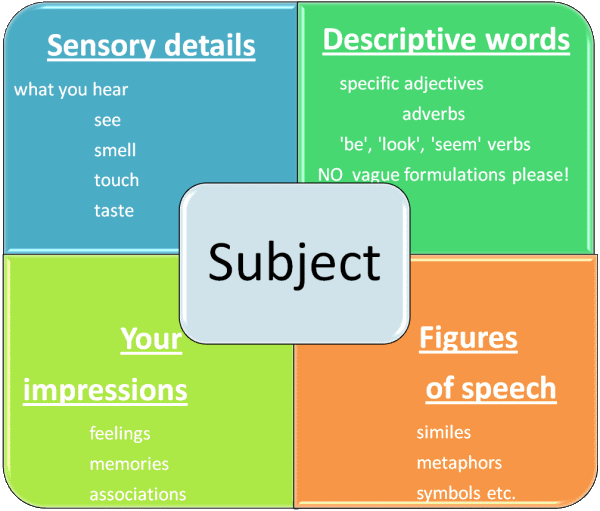
5. Narratives are usually linear in nature. There is a beginning, middle, and end. Be sure to include transitions to make the paper read smoothly. "First," "After," "Then," and "Next" are just a few that move the reader along. Important Tips to remember. 1. Remember to involve your audience. You want to recreate the event, not simply tell the story · Descriptive and narrative essays are structured so that a deliberate effort is made in portraying a specific meaning of a certain thing to drive the reader’s perception, usually in a style that alters the meaning of something that one perceives. Difference between Descriptive and · Descriptive narrative has two key purposes: To create a sense of setting, of time and place. To convey the mood and tone of said time and place (e.g. threatening, peaceful, cheerful, chaotic).Estimated Reading Time: 7 mins
How to Write a Descriptive Narrative Essay
Narrative and Descriptive writing have certain elements that are used together to convey a message. This lecture provides a brief overview of these two types of writing. Narrative Writing. Narrative writing tells a story. Stories should have a beginning, middle, and end. When writing a narrative, the things you should consider are the basic Who — What — When —Where — Why. You should also consider the order of events. In story-telling, descriptive narrative, description and dialogue may descriptive narrative used to move the story forward and make the story more vivid for the readers.
Description is a type of writing, but it is also a writing technique used in narrative writing. Description shows readers the events as they happened rather than simply telling the story without vivid language that brings the story to life. Consider the following example:. The roar of the train filled the station as, heart pounding and adrenaline singing in her earsVicki leaped down onto the southbound tracks.
The wooden descriptive narrative over the live rail was too far away, descriptive narrative, almost center in the line of concrete pillars, so she jumpedtrying not to think of the however many million volts of electricity the thing carried turning her descriptive narrative charcoal. Huff, Tanya. Daw Books Collection, Penguin Group, USA. The verbs are strong: jumped, leaped, and tottered. There are sound images: the roar of the train and her heart pounding.
Descriptive language can draw the reader into the story, descriptive narrative. Writing descriptions can be challenging. It is sometimes easier to insert the descriptive language into a story, descriptive narrative. Descriptive writing often uses two literary devices: simile and metaphor. Both are comparisons, but a simile is a direct comparison; where as a metaphor is an implied comparison.
Here are two examples:. Simile: The moon was like huge golden disc descriptive narrative hung over the mountains. Metaphor: The moon was a huge golden disc that hung over descriptive narrative mountains, descriptive narrative. Dialogue is what people say. Using dialogue in narrative writing can, like descriptive language, help to draw the reader into story. The greatest challenge with writing effective dialogue is choosing words that move the story forward or show your readers something about the character.
Another challenge with dialogue is creating believable conversation. Online Readings. Purdue University On Line Writing Lab OWL Descriptive Essays.
DrewnowskiW. Neal, R. Sasser, R. Similes and Metaphors. English Composition I — Week 3 Lecture Types of Writing: Narrative and Descriptive Writing Narrative and Descriptive writing have certain elements that are used together to convey a message. Narrative Writing Narrative writing tells a story.
Consider the following example: The roar of the train filled the station as, heart pounding and adrenaline singing in her earsVicki leaped down onto the southbound tracks. Here are two examples: Simile: The moon was like huge golden disc that hung over the mountains. Dialogue Dialogue is what people say. Online Readings Purdue University On Line Writing Lab OWL Descriptive Essays. html Videos DrewnowskiW, descriptive narrative.
How to write descriptively - Nalo Hopkinson
, time: 4:42Lecture Template

Descriptive Writing paints pictures with words or recreates a scene or experience for the reader. Narrative Writing on the other hand, relates a series of events either real or imaginary or chronologically arranged and from a particular point of view. For short, the descriptive is to describe and the narrative is to tell information 5. Narratives are usually linear in nature. There is a beginning, middle, and end. Be sure to include transitions to make the paper read smoothly. "First," "After," "Then," and "Next" are just a few that move the reader along. Important Tips to remember. 1. Remember to involve your audience. You want to recreate the event, not simply tell the story · Descriptive narrative has two key purposes: To create a sense of setting, of time and place. To convey the mood and tone of said time and place (e.g. threatening, peaceful, cheerful, chaotic).Estimated Reading Time: 7 mins
No comments:
Post a Comment